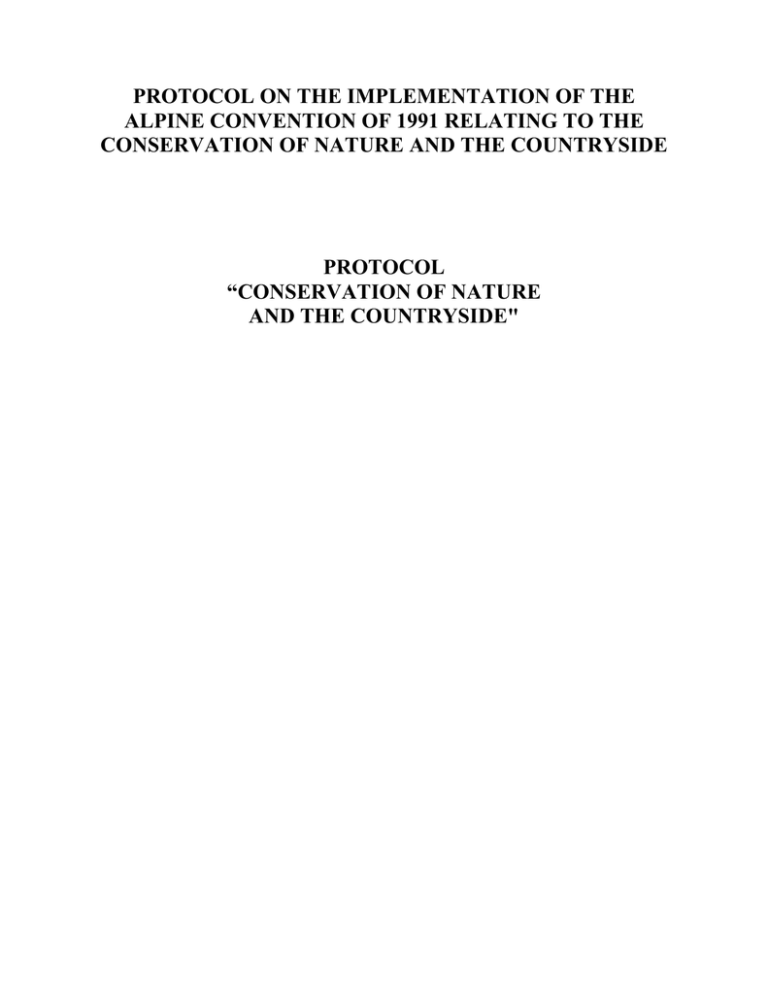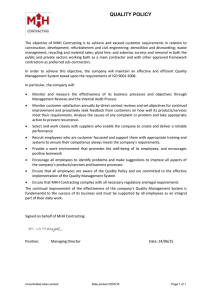PROTOCOL ON THE IMPLEMENTATION OF THE
advertisement

PROTOCOL ON THE IMPLEMENTATION OF THE ALPINE CONVENTION OF 1991 RELATING TO THE CONSERVATION OF NATURE AND THE COUNTRYSIDE PROTOCOL “CONSERVATION OF NATURE AND THE COUNTRYSIDE" Preamble The Republic of Austria, the French Republic, the Federal Republic of Germany, the Italian Republic, the Principality of Liechtenstein, the Principality of Monaco the Republic of Slovenia the Swiss Confederation, and the European Community, - in accordance with their task, arising from the Convention on the Protection of the Alps (Alpine Convention) of 7 November 1991, of pursuing a comprehensive policy for the protection and sustainable development of the Alpine region, - in compliance with their obligations under Article 2(2) and (3) of the Alpine Convention, - aware that Alps are one of the largest continual natural spaces in Europe, set apart for its unique beauty, ecological diversity and extremely sensitive ecosystems, while also being home to and a living for the local population that has a culture of rich tradition, - convinced that the local population must be able to determine its own social, cultural and economic development plan and take part in its implementation in the existing institutional framework, - considering the territorial structure of the Alps which is worked in many, often competing, ways in concentrated areas of narrow valleys, helping to undermine an ecologically important environment, - aware that, in huge areas, the ways and intensity of using the Alpine territory in recent decades have caused, and will continue to cause if perpetuated, irrecoverable losses of elements of the landscape, biotopes and species worth preserving, - knowing that in certain areas of the Alpine territory there has been or may be an excessive compromising of nature and the landscape, particularly due to the concentration of traffic, tourism, sport, urbanisation, economic development, intensifying of agriculture and forestry, - aware of the eminent importance held particularly by glaciers, Alpine meadows, mountain forests and the waterways of the Alpine territory, which form the habitat of the wide variety of fauna and flora species, - aware of the great importance of agriculture and forestry conducted extensively for conserving and caring for the rural landscape and the connected natural elements, - convinced that economic interests must be reconciled with ecological needs, - convinced that, in deciding between ecological tolerance and economic interests, priority should be given to ecological needs if this were necessary for maintaining the fundamentals of natural life, - aware that the limited tolerance of the Alpine territory requires regulations and measures of a specific character for conservation and the restoring of the correct natural balance, - convinced that certain problems can only be resolved in a cross-border framework and require joint measures by the Alpine States, have agreed as follows: Chapter I General Provisions Article 1 Objectives The objective of this Protocol is to lay down International laws, implementing the Alpine Convention and also taking the interests of the local population into account, in order to protect, care for and, to the extent necessary, restore nature and the countryside, in such a way as to ensure the lasting and widespread functional efficiency of the ecosystems, the conservation of countryside elements and wild animal and plant species together with their habitat, the regenerative ability and lasting productivity of natural resources, and also the diversity, specificity and beauty of the natural and rural landscape; and also, in order to encourage cooperation between the Contracting Parties for these purposes. Article 2 Fundamental commitments In accordance with this Protocol, each Contracting Party undertakes to adopt the measures necessary to ensure the protection, care and, to the extent necessary, the restoring of nature and the landscape of the Alpine territory, together with the wild animal and plant species, their diversity and their habitat, while also considering the possibility of their ecologically tolerable usage. Article 3 International cooperation 1. The Contracting Parties undertake to cooperate particularly for: map surveying, drawing the boundaries and then managing and controlling protected areas and other natural and rural elements of the landscape worthy of protection, interconnecting a network of biotopes, defining landscape models, programmes and/or plans, preventing and rebalancing damage to nature and the landscape, systematically monitoring nature and the countryside, scientific research, and any other measure for protecting wild animal and plant species, their diversity and their habitat, and for defining the relevant comparable criteria to the extent that this is necessary and functional. 2. They undertake to encourage cross-border cooperation relating to conservation of nature and the countryside, at a regional and local level, to the extent necessary for achieving the objectives of this Protocol. 3. They will aim to combine the framework conditions for adopting limitations to the uses for the purposes of this Protocol’s objectives. Article 4 Taking account of the objectives in other policies The Contracting Parties undertake to also consider the objectives of this Protocol in their other policies, particularly in the area of: territorial and urban planning, safeguarding the air quality, defence of the soil, protecting the water balance and the quality of the water, tourism, agricultural and forestry economy, transport and energy policies, industry and manufacturing, management of waste; and also in the area of training, education, research and information, as well as in the area of cross-border coordination of the measures. Article 5 Participation of the regional and local authorities 1. Each Contracting Party shall define, within its institutional framework, the best level of coordination and cooperation between the institutions and regional and local authorities directly concerned so as to encourage solidarity of responsibility, in particular to exploit and develop potential synergies when applying nature and countryside conservation policies and implementing measures under them. 2. The regional and local authorities directly concerned shall be parties to the various stages of preparing and implementing these policies and measures, within their competence and within the existing institutional framework. Chapter II Specific Measures Article 6 Inventories The Contracting Parties undertake to present, three years after this Protocol comes into force, a report on the current situation of the conservation of nature and the countryside, in relation to the matters listed in Annex I. These presentations are to be updated regularly, at least once every ten years. Article 7 Landscape planning 1. Within five years of this Protocol coming into effect, the Contracting Parties will set out models, programmes and/or plans by which will be defined the requirements and the measures for achieving the objectives of nature and countryside conservation in the Alpine territory. 2. In the models, programmes and/or plans, as at point 1 above, there are to be presented: a) the current situation of nature and the countryside and its evaluation, b) the condition of nature and the countryside being aimed for, as well as the measures necessary for its achievement, specifically: - the general measures for protection, management and development, - the measures for protecting, managing and developing certain parts of nature and the countryside, and - the measures for protecting and managing the wild animals and plants. Article 8 Planning The Contracting Parties shall adopt the measures necessary so that the preservation and development of the natural or near-natural habitats of wild animal and plant species and of other structural elements of the natural and rural landscape are pursued on the basis of landscape planning aligned with the territorial planning. Article 9 Actions on nature and the countryside 1. The Contracting Parties shall create the prerequisites to ensure that, in the cases of measures and projects, whether private or public, that could significantly and lastingly undermine nature and the countryside, the direct and indirect effects on the natural balance and the landscape structure are assessed. The result of the assessment is to be considered when authorising and/or constructing such projects, particularly assuring that any avoidable impairments do not occur. 2. In accordance with national law, unavoidable impairments must be offset by measures for conservation of nature and the countryside, while the impairments that cannot be compensated may only be allowed on condition that, having evaluated all the interests, the needs for nature and countryside conservation are not dominant. However, even in these cases, measures must still be taken to conserve nature and the countryside. Article 10 Basic protection 1. The Contracting Parties shall aim to reduce the environmental impact and impairments undermining nature and the countryside in the entire Alpine territory, while also taking account of the interests of the local population. They shall take steps to ensure that all the significant uses of the territory are with due care for nature and the countryside. They shall also adopt all the measures necessary for preserving and, to the extent necessary, restoring special structural, natural and near-natural elements of the landscapes, biotopes, ecosystems and traditional rural landscapes. 2. In view of the decisive role of agriculture and forestry economy when producing measures for the conservation of nature and the countryside, protecting, preserving and managing nearnatural biotopes worthy of protection should be undertaken by the correct and appropriate agricultural and forestry exploitation, on the basis of agreements with the owners or managers of the land, wherever appropriate. In this respect, control instruments borrowed from the market economy, such as incentives and financial compensation, are particularly opportune. 3. To augment the means available for protecting nature, it will be necessary that the use of incentives and measures for supporting the agricultural and forestry economy, as well as other types of exploitation of the territory, is further applied to achieve these objectives. Article 11 Protected areas 1. The Contracting Parties undertake to preserve, manage and, where necessary, to extend the existing protected areas, in keeping with their protective function, and also to define, where possible, new protected areas. They shall take all appropriate measures to avoid impairing or destroying these areas. 2. They shall also promote the instituting and management of national parks. 3. They shall set aside areas of respect and tranquillity that ensure giving priority to the wild animal and plant species over other interests. They shall ensure that, in these areas, there is the peace necessary for the ecological process typical of the species to take place undisturbed, and shall reduce or prohibit any form of use incompatible with the ecological processes of these areas. 4. The Contracting Parties shall examine the compensation terms of the special services provided by the local population, in compliance with national law. Article 12 Ecological network The Contracting Parties shall pursue the measures appropriate for creating a national and crossborder network of protected areas, biotopes and other environmental assets protected or acknowledge as worthy of protection. They shall undertake to harmonise the objectives and measures with the cross-border protected areas. Article 13 Protection of types of biotopes 1. The Contracting Parties undertake to adopt the measures necessary to ensure the lasting preservation of the natural or near-natural biotopes of a sufficient size and with territorial distribution according with their functions. They shall also promote the re-naturalisation of the impaired habitats. 2. For the purposes of preparing the valid lists for the entire Alpine territory, the Contracting Parties undertake to indicate, within two years of this Protocol coming into effect, the types of biotopes requiring the adopting of measures in accordance with paragraph 1. Article 14 Protection of the species 1. The Contracting Parties undertake to pursue the measures appropriate for preserving the indigenous animal and plant species with their specific diversity and in sufficient populations, particularly ensuring that they have sufficiently large habitats 2. For preparing the valid lists for the entire Alpine territory, the Contracting Parties shall indicate, within two years from this Protocol coming into effect, the species that require special protection measures since they are specifically threatened. Article 15 Prohibition on removal or trading 1. The Contracting Parties shall prohibit the capture, possession, injuring and killing of certain animal species, and disturbing them particularly during their periods of reproduction, growth and wintering, and also any destruction, removal or collecting of eggs coming from nature, and the possession, offer, purchase or sale of specimens of the same, or parts of them, taken from nature. 2. For certain vegetal species, the Contracting Parties shall prohibit the gathering, collecting, cutting, disinterring or uprooting of the relevant plants or parts thereof from their natural position, and the possession, offer, purchase and sale of specimens of the same varieties taken from their natural habitat. This prohibition does not apply to the use and care of the plant conservation areas. 3. The Contracting Parties shall indicate within two years of this Protocol coming into effect the animal and plant species protected by the measures as at points 1 and 2. 4. The Contracting Parties can apply exceptions to the above provisions, as required by needs of: a. a scientific nature b. protecting the fauna, the wild plants or the natural environment c. public health and safety d. preventing significant economic damage, particularly for crops, breeding, forests, fishing and waters. These exceptions are allowed on condition that there are no other suitable solutions and the actions are not such as to threaten the natural balance of the complex of the species concerned. These exception must be accompanied by control measures and, if necessary, means of compensation. 5. Regardless of when this Protocol comes into effect, the Contracting Parties undertake to specify and define, as early as possible and by means of technical supplements, the periods of reproduction, growth and wintering, as stated in point 1, and any other definition that may be difficult to interpret scientifically. Article 16 Reintroduction of indigenous species 1. The Contracting Parties shall undertake to promote the reintroducing and distribution of wild, indigenous animal and plant species and also subspecies, breeds and ecotypes, on condition that there are the necessary prerequisites and, by doing this, there is a contribution to the preservation and strengthening of those species and that no effects unsustainable to nature and the landscape, or to human activities, are caused. 2. Scientific knowledge is to be applied for reintroducing and distributing these species. The Contracting Parties shall agree on common directives in this respect. Following the reintroduction, it will be necessary to control and, if required, regulate the development of these animal and plant species. Article 17 Prohibition on introducing species The Contracting Parties shall assure that no wild animal or plant species are introduced into a region that were not previously present naturally for a verifiable historic period. Exceptions can be made in cases in which such introducing is necessary for certain uses and will not lead to negative effects on nature and the landscape. Article 18 Release of Genetically Modified Organisms The Contracting Parties shall ensure that genetically modified organisms are only released into the environment when, on the basis of a formal evaluation, such release will not lead to any risk for man and the environment. Article 19 Further Measures The Contracting Parties may take additional measures to those stated in this Protocol for the conservation of nature and the countryside. Chapter III Research, Education and Information Article 20 Research and monitoring 1. The Contracting Parties shall cooperate closely to promote and harmonise research and systematic monitoring programmes for nature and countryside conservation as well as their animal and plant species, with particular attention to the research subjects set forth in Annex II. 2. The Contracting Parties shall develop joint or coordinated programmes for analysing and assessing ecosystems with the aim of extending scientifically validated knowledge to help achieve the measures as describe in this Protocol. 3. The Contracting Parties shall ensure that the national results of the research and systematic observation are integrated in a joint permanent observation and information system and that they are made accessible to the public under the existing institutional framework. Article 21 Education and information The Contracting Parties shall promote education and further training as well as keeping the public informed about objectives, measures and the implementation of this Protocol. Chapter IV Implementation, Monitoring and Evaluation Article 22 Implementation The Contracting Parties undertake to ensure the implementation of this Protocol by taking any appropriate measures within the existing institutional framework. Article 23 Monitoring of compliance with obligations 1. The Contracting Parties shall regularly report to the Standing Committee on measures taken under this Protocol. The reports shall also cover the effectiveness of the measures taken. The Alpine Conference shall determine the intervals at which the reports must be submitted. 2. The Standing Committee shall examine these reports in order to ensure that the Contracting Parties have fulfilled their obligations under this Protocol. It may also ask for additional information from the Contracting Parties concerned or have recourse to other information sources. 3. The Standing Committee shall draw up a report on the compliance of the Contracting Parties with the obligations arising from the Protocol, for the attention of the Alpine Conference. 4. The Alpine Conference shall take note of this report. If it finds that obligations have not been met, it may adopt recommendations. Article 24 Evaluation of the effectiveness of the provisions 1. The Contracting Parties shall regularly examine and evaluate the effectiveness of the provisions of this Protocol. They shall consider the adoption of appropriate amendments to this Protocol where necessary in order to achieve objectives. 2. The regional and local authorities shall take part in this evaluation within the institutional framework. Non-governmental organisations active in this field may be consulted. Chapter V Final Provisions Article 25 Links between the Alpine Convention and the Protocol 1. This Protocol constitutes a Protocol to the Alpine Convention within the meaning of Article 2 thereof and any other relevant articles of the Convention. 2. Only Contracting Parties to the Alpine Convention may become a party to this Protocol. Any denunciation of the Alpine Convention also implies denunciation of this Protocol. 3. Where the Alpine Conference discusses matters relating to this Protocol, only the Contracting Parties to this Protocol may take part in the vote. Article 26 Signature and ratification 1. This Protocol shall be open for signature by the Signatory States of the Alpine Convention and the European Community on 20 December 1994 and from 15 January 1995 in the Republic of Austria as the depositary. 2. This Protocol shall enter into force for the Contracting Parties which have expressed their agreement to be bound by the said Protocol three months after the date on which three States have deposited their instrument of ratification, acceptance or approval. 3. For Parties which express their agreement to be bound by the Protocol at a later date, the Protocol shall enter into force three months after the date of deposit of the instrument of ratification, acceptance or approval. After the entry into force of an amendment to the Protocol, any new Contracting Party to the said Protocol shall become a Contracting Party to the Protocol, as amended. Article 27 Notifications The depositary shall, in respect of this Protocol, notify each State referred to in the Preamble and the European Community of: a) each signature, b) the deposit of each instrument of ratification, acceptance or approval, c) each date of entry into force d) each declaration made by a Contracting Party or signatory, e) each denunciation notified by a Contracting Party, including the date on which it becomes effective. In witness whereof the undersigned, being duly authorised thereto, have signed this Protocol. Done at Chambéry on 20 December 1994 in the French, Italian, Slovene and German languages, the four texts being equally authentic, the original text being deposited in the Austrian State Archives. The depositary shall send a certified copy to each of the signatory States. For the Republic of Austria: For the French Republic: For the Federal Republic of Germany: For the Italian Republic: For the Principality of Liechtenstein: For the Principality of Monaco: For the Republic of Slovenia: For the Swiss Confederation: For the European Community: Annex I List of materials inventoried in accordance with article 6 1. Condition of the wild plant and animal species and their biotopes 1.1. Status of surveys of wild plant species and the phytocoenosis 1.1.0. General indications 1.1.1. Red lists 1.1.2. Lists of species protected by law 1.1.3. Atlases of distribution 1.2. Status of surveys of wild animal species 1.2.0. General indications 1.2.1. Red lists 1.2.2. Lists of species protected by law 1.2.3. Atlases of distribution 1.3. Survey status of biotopes 1.3.0. General indications 1.3.1. Red lists of biotope types 1.3.2. Lists of biotopes of ecological value, including waterways 1.4. Survey status of landscapes 1.4.0. General indications 1.4.1. Inventories, lists, types of natural landscapes and countryside worthy of protection 1.4.2. Plans and other measures for protecting particular landscapes and types of landscapes and/or singles elements of the natural landscape and countryside 1.4.3. Areas to reclaim 1.5. Use of wild animal and plant species and/or biotopes 1.5.1. Agriculture and pasture farming (for instance: problems/risks from the intensification of uses and the neglect of lands, losses and gains) 1.5.2. Forestry 1.5.3. Hunting 1.5.4. Fishing 2. Protected areas (area sizes, percentage of the total territory, protective aim, protective functions, uses, structure of uses, ownership conditions) 2.1. National parts 2.2. Nature protection areas 2.3. Landscape protection areas 2.4. Wildlife reserves 2.5. Areas of respect and tranquillity 2.6. Components of the landscape protected 2.7. Protected biotopes 2.8. Other protected areas (for instance: areas protected by private right, voluntary agreements, and private contracts for extensive management) 3. Organising the conservation of nature and the countryside (structure, remits/actions, staff and financial resources) 3.1. Competent administrations for nature conservation 3.2. Other administrations in sectors with functions for nature conservation, other institutions under public and private law (e.g.: bodies, foundations) 3.3. Advisory bodies for nature conservation 3.4. Supervisory bodies for nature conservation 3.5. Associations for nature conservation 3.6. Associations for safeguarding the landscape 3.7. Others 4. Legal bases (for the respective levels of authority) 4.1. Constitutional law 4.2. Sources of law (laws, orders, directives, including the representation of specific contents for protecting the Alps). 4.3. Participation of associations, legal proceedings initiated by the associations 4.4. Indications on the procedures 4.5. Cooperation from the administrations in charge of nature conservation with administrations from other sectors 4.6. Catalogues of fines, etc. 4.7. Funds for the conservation of nature and the countryside 4.8. Current or planned revising of the law 5. Actions for nature conservation (general overview) 5.1. Models, programmes, directives for nature conservation in the Alpine territory 5.2. Plans (for instance, landscape plans, plans for care and development) 5.3. Measures for promoting species and other measures for care, safeguarding and management 5.3.1. General indications 5.3.2. Programmes for promoting species 5.3.3. Breeding and release points 5.4. Strategies, models, programmes, forms of cooperation with those in charge of uses, whether individuals or organisations (for instance, programmes for extensive management and in favour of mountain farmers) 5.5. Scientific support, long-term observation of areas/species 5.6. Independent actions for protecting areas and species by the nature protection associations 5.7. Funding programmes (total of funds, objectives, areas of action) 6. Education and public information (institutions/voluntary work) 6.0. General indications 6.1. Training centres focused on nature protection 6.2. Information centres focused on nature protection 6.3. Publications 6.4. Other 7. Conclusions, recommendations for measures Annex II Priority subjects for research referred to in article 20 A. Long-term observing of the development of ecosystems (habitat, biocoenesis, populations, species) for research into development trends and changes caused by environmental influxes. Note: bioindication, biomonitoring, cause-effect analysis, documentation B. Research into the efficiency of protected areas. Note: representativeness, efficiency, regeneration, management, systemic analysis C. Research into the species and populating. Note: genetics, dynamics, distribution, biological diversity D. Research into the aspects of extended territorial importance of protection and of agricultural and forestry uses. Note: productions caring for nature, ecological rebalancing, biotope networks, extensive management, containing of the populating of game animals E. Research for the improvement of methods, procedures and specific plans. Note: Red lists, maps of biotopes, protected areas, landscape planning, actions on nature and the landscape, information systems F. Development of strategies and models for the conservation of nature and the countryside. Note: Strategic objectives and possibilities of success, models of protection, extensive management, market economy instruments, acceptance by public opinion.








